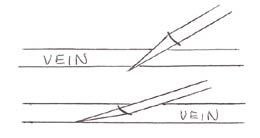Bevel of Needle When Drawing Blood
By Kelly Grayson
Early in my career, I discovered a love for pediatrics. Most medics count calls involving children among their most stressful, but I've always been one of those weird types who looked forward to them. Doesn't matter if it's a fussy infant or a sullen adolescent, I'm in my comfort zone when dealing with kids.
My parents would tell you that my comfort in assessing and treating children can be traced to a childhood fascination with veterinary medicine; the two disciplines have much in common. My ex-wife, on the other hand, would probably tell you that kids and I get along because they intuitively sense that I'm developmentally stuck at age seven.
In truth, it's probably a little of both.
But being the guy who is comfortable dealing with sick kids is a double-edged sword, because whenever the call came in for a pediatric transfer, I got it. If a medic needed backup on a pediatric code, I was sent if I was anywhere nearby. When I worked in the ER as a paramedic, I was the designated kid-sticker. The rewards of helping sick children are substantially lessened when you're the guy everyone asks to perform painful procedures on them.
But in my years as a medic, I've learned a few techniques to minimize the muss and fuss of poking squirming children with sharp objects: First, minimize the lag time between telling the kid about a painful procedure and actually doing it; second, bribery works; and third, use the bevel-down IV technique.
Most of us were taught to start our IV's bevel-up, but when you're trying to thread a plastic catheter into a tiny little vein, quite often the leading edge of your trocar pierces the opposite wall of the vein before you're ready to advance the catheter.
So there you are, needle in the vein, catheter still outside it. Perhaps you try to shallow the angle of your needle and advance a bit, and as often as not, you see the hematoma form at the same time you notice flashback in the catheter hub.

If you've ever had that happen to you, try inserting your IV catheters bevel-down. Doing so will make the angle of insertion much more shallow, thus minimizing the chance of poking the very end of that needle through the opposite wall before the tip of your cannula enters the lumen of the vein.
It's an old trick, first taught to me by a neonatal intensivist in my very first PALS class some fifteen years ago. It takes some practice, and with certain types of shielded IV catheters, more than a little gymnastics, but the technique can be mastered with all types of shielded catheters. Or, if you prefer, keep a few of the old, non-shielded IV catheters on hand especially for this purpose.
The medical literature on the technique is equivocal, with most studies showing no increase in success when comparing bevel-down IV insertion compared to the conventional technique. However, like most studies involving matters of technique, it is hard to quantify the individual skill level of the provider or their familiarity with the technique being evaluated.
If sticking tiny little veins in pediatric patients — or, for that matter, geriatric patients — always makes you pause, consider using the bevel-down IV technique. If you have access to an IV therapy manikin, practice the technique on it. You may find it a useful trick one day.
About the author
Kelly Grayson, NRP, CCP, is a critical care paramedic in Louisiana. He has spent the past 24 years as a field paramedic, critical care transport paramedic, field supervisor and educator. He is president of the Louisiana Society of EMS Educators and a board member of the LA Association of Nationally Registered EMTs.
He has an Associate of General Studies degree from Louisiana State University at Eunice, Nunez Community College. Kelly has been recognized as the 2016 Louisiana Paramedic of the Year, 2002 Louisiana EMS Instructor of the Year and 2002 Louisiana AHA Regional Faculty of the Year, and with the 2012 Maggie Award for Best Regularly Featured Web Column/Trade and the 2014 Folio Eddie Award for Best Online Column.
He is a frequent EMS conference speaker and contributor to various EMS training texts, and is the author of the popular blog A Day In the Life of an Ambulance Driver, "En Route: A Paramedic's Stories of Life, Death and Everything In Between," and "On Scene: More Stories of Life, Death and Everything In Between." You can follow him on Twitter (@AmboDriver), Facebook, LinkedIn, or email him at kelly@ambulancedriverfiles.com. Kelly is a member of the EMS1 Editorial Advisory Board.
Bevel of Needle When Drawing Blood
Source: https://www.ems1.com/ems-training/articles/the-bevel-down-technique-zXj4bKc8fWzMfL6W/
0 Response to "Bevel of Needle When Drawing Blood"
Post a Comment